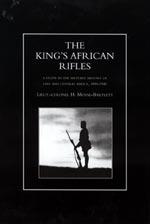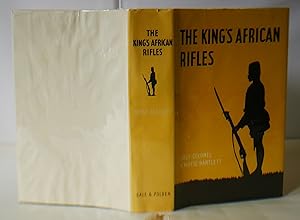lieut col h moyse bartlett (2 resultados)
Tipo de artículo
- Todo tipo de artículos
- Libros (2)
- Revistas y publicaciones
- Cómics
- Partituras
- Arte, grabados y pósters
- Fotografías
- Mapas
-
Manuscritos y
coleccionismo de papel
Condición
- Todo
- Nuevos
- Antiguos o usados
Encuadernación
- Todo
- Tapa dura
- Tapa blanda (1)
Más atributos
- Primera edición
- Firmado
- Sobrecubierta
- Con imágenes del vendedor
- Sin impresión bajo demanda
Ubicación del vendedor
Valoración de los vendedores
-
KINGâ S AFRICAN RIFLES. A Study in the Military History of East and Central Africa, 1890-1945
Publicado por Naval and Military Press, 2016
ISBN 10: 1843423944ISBN 13: 9781843423942
Librería: Naval and Military Press Ltd, Uckfield, Reino Unido
Libro
SB 2 Volumes xix + 727pp with 41 b/w photos, 47 B&W maps and sketches in text and 11 B&W mapsPublished Price £24.95 This is a regimental history with a difference, one that is bound up with the history of the British Empire in Africa and the extension and development of British rule in the territories of Somaliland, British East Africa (redesignated Kenya from July 1920), Uganda, Nyasaland and, after 1918, Tanganyika (previously German East Africa). These were the territories that were the recruiting grounds for the KAR to which officers from the British Army were seconded - there were no permanent commissions in the KAR unlike the Indian Army which had its own officer structure. No regiment has ever been more intimately connected with the territory through which it marched and fought, or with the peoples from which it was recruited. It was a unique regiment. The author has arranged the book in five parts: The Campaigns of the Early Regiments; The Consolidation of the Regiment, 1901-1914; The East Africa Campaign, 1914-1918; Internal Security and Reorganization 1914-1939; and The War of 1939-1945.The story begins with the political background to the British administration in East and Central Africa up to the close of the nineteenth century. During the last decade of that century three regiments were formed which were the forerunners of the K.A.R - The Central African Regiment, The Uganda Rifles and the East African Rifles. These saw action in various expeditions and campaigns, in Mauritius, Somaliland, The Ashanti War, The Gambia Expedition, Expeditions against the Nandi and others. On 1 January 1902 the Kingâ s African Rifles came into being, incorporating the original regiments as battalions, six battalions: 1st and 2nd (Central Africa); 3rd (East Africa); 4th and 5th (Uganda) and 6th (Somaliland) Battalions. The total strength was returned as 4,683 officers and men, including104 British officers. For the new regiment the main operations before WWI were the campaigns against the Mad Mullah of Somaliland involving four expeditions; he wasnâ t finally seen off until 1920. During the Great War there were 21 battalions and at peak strength in July 1918 the K.A.R. numbered 1,193 officers, 1,497 British NCOs and 30,658 Africans; casualties amounted to 5,117 with a further 3,039 died of disease. The regimentâ s part in the campaign against von Lettow-Vorbeck in East Africa is fully described.The regiment was again in action during WWII taking part in three separate campaigns: the defeat of the Italians in Somalia and Abyssinia; the occupation of Madagascar against the opposition of the Vichy French; and the reconquest of Burma when, for the first time, K.A.R. battalions fought outside the continent of Africa. This must be one of the best regimental histories ever written.
-
The Kings African Rifles A Study Of Military History Of Easy And Central Africa 1890-1945
Publicado por Gale of Polden, Aldershot, 1956
1st Edn. xiv 727 pages, b/w illustrations from photographs, 11 folding maps, text maps etc., publisher's black cloth, gilt regiment crest to upper board, cloth clean and bright, a vg+ copy in likewise dj. Although a regimental history the book is an insight to the area of Uganda, Kenya, Somaliland during a formative period.



